
|
ICE Case Studies |
|
I. Case
Background |

There are more than 3,000 dams in India 's Narmada River Valley. Government officials say these dams and an extensive irrigation system will bring electricity and water to areas of the country suffering from drought, and the technocrats insist that it will work. But other voices challenge this, most notably the Narmada Bachao Andolan (NBA). Arguing that the government exaggerates the benefits and underestimates the costs, this nonviolent people's movement since the mid-1980s has focused attention on the human suffering and environmental damage that comes with "big dams." These dams flood vast areas and displace hundreds of thousands, mostly peasants and adivasi (tribal/indigenous people) people, while promises of relocation and resources usually prove to be illusory. Just one of the dams, Sardar Sarovar, could uproot as many as a half-million people. This case study focuses on the Sardar Sarovar dam, the largest of all the constructed dams, and its effects on the ecosystem and the inhabitants of the region. It should be noted that the story of those involved in the protection of their homes in the face of the Sardar Sarovar Project (SSP) are not unique, in that their story is repeated time and again throughout India as big dam construction persists.
A. INTRODUCTION/HISTORY
According to the World Commission on Dams' (WCD) report, large dams have not been as development-effective as claimed, and that these dams are responsible for the displacement of 40-80 million people. Furthermore, millions more of downstream communities are adversely affected. 1 The 45,000 large dams in the world reportedly fragmented and irreperably damaged 60 % of the worlds rivers.2 The report also stated that large dams building is marred with corruption and favored politicians, governments, dam builders and funders such as the World Bank, yet they have not been held accountable to the tremendous adverse impacts of large dams.3 Coupled with these staggering statistics is the fact that, simply, the target level of benefits of water supply, irrigation and flood control have never been achieved.
The idea to build dams on the Narmada River was first devised in 1863 when a British entrepreneur intimated that with adequate irrigation, crops that would other-wise not survive in the drought prone climate of Gujarat, could flourish.4 From this, there sprouted technical studies in the 1940's. Eventually, the Central Water and Power Commission concluded that the site of the "terminal dam on the river" should be at Navagam, Gujarat, and recommended that the dam be built in two stages: the first stage being a full reservoir height of 160 feet; the second being an upgrade to 300 feet.5
B. HISTORY
By 1959, the recommended full reservoir height was changed to 455 feet, due to the conclusion that canals could be used to transport water to the Kutch region (in Gujarat) and the state of Rajasthan (460 Km away from the dam). 6 In the 1960's, a dispute arose between the states most directly affected by the dam, Madhya Pradesh, Gujarat, and Maharashtra, over the particularities regarding who would bear the primary costs of funding the dam, as well as how the river's resources would be distributed between the states. From this dispute, the Narmada Water Dispute Tribunal (NWDT) was formed, which for ten years developed a plan to address the concerns of these states fairly. In the end, the tribunal determined that 65% of the river's resources should go to Madhya Pradesh, Gujaret should reciev 32%, Rajasthan got 2%, and Maharashtra received 1% of the river's resources. 7 As of 1983, the SSP had not met the Ministry of Environment and Forest Regulations, and therefore was denied clearance for construction.
Construction of the Sardar Sarovar Project (SSP) officially began in 1985 when the World Bank decided to provide finacial support (to the tune of a $450 million USD loan) for the construction of the Sardar Sarovar Dam.8 However, this was only made possible through the efforts and political pressures of Prime Minister Rajiv Gandhi's Congress party, coupled with the increase in damage from severe droughts in Gujarat, all of which prompted the Central Government to grant conditional clearance for construction.9 It was proclaimed by project coordinators and government officials that the Sardar Sarovar Dam was to benefit the greater well-being of the country by producing power sources and more widespread availability of electricity, and improving water management in general. In particular, the "SSP is intended to bring drinking water to Kutch and other drought-ridden regions of Gujarat," impounding water in a 455 foot high reservoir that will ultimately submerge 37,000 hectares of land in three states of Gujarat, Maharashrta and Madhya Pradesh.10 The dam will also divert 9.5 million acre feet of water into a canal and irrigation system. This canal, at 450 kilometers long, is the largest in the world, with the aggregate length of the distribution network being 75,000 kilometers. It will require 150,000 hectares of land.11
C. DYNAMICS OF THE CONFLICT
Despite these plans, the truth, even from a purely objective perspective, is that the impact of the construction of this dam, like many other dams around the world and in India, has created a social malaise, as the contruction and heigtening of the dam reflects the destruction and devolution of those regions surrounding the dam site. Particularly, the SSP has been the fault-line of violence between the state and the poor peasants fighting to prevent the state from displacing them from their homes and families. There have been ample first-person accounts and third-party observations of countless state-sanctioned violations of human rights against peacable protesters and inhabitants simply struggling for a means to survive.12 These people believe deeply that "[t]he Sardar-Sarovar dam and irrigation project in India ’s Narmada Valley will primarily benefit a small number of wealthy farmers, while the burdens—flooding of villages and arable land, decimation of local fisheries, and loss of ancestral land and cultural monuments—will fall on hundreds of thousands of poorer peasants."13 There is serious doubt that the "intended aims" of the SSP, namely the provision of water to drought-ridden areas, will ever be fulfilled. "There is no funding for this part of the canal system, and it is unclear whether there is even enough water in the river to supply these areas."14 Rather, villages and surrounding ecosystems are destroyed and displaced persons' lives are reduced to shambles. An estimated 150,000 people will be displaced due to the Sardar Sarovar Dam. This is not just a simple matter of relocating, as these people are indigenous farmers and peasants, with a set cultural and social interrelationship with one another, and distinct from those social ties and arrangements in the larger cities of India. Their entire way of life is essentially being destroyed.
After six years of of reports of violations of resettlement and environmental guidelines by developers and authorities, the World Bank formed an independent commisision to review the project.15 This independent commision (The Morse Commision) issued a report in 1992, describing the devastating effects of the dam and a harsh critique of the World Bank's negligent role in supporting the project in the face of so much negative evidence of the dam's impact. In its report, the commission came to the conclusion that "the Sardar Sarovar Project is flawed, that rehabilitation of all the people affected cannot be done within the allotted time, and that important datea are missing in just about all areas."16 The World Bank did not immediately withdraw its funding, but rather provided the loan, conditionally. The day before the deadline, India cancelled the remainder of the loan.
Today, the N.W.D.T exists as an organization designated to lay out the conditions of resettlement and rehabiliation of people displaced by the Sardar Sarovar Dam.17 Specifically, the tribunal established that all Projected Affected Families (PAF's) would be facilitated in re-establishing themselves in communities that have "access to water, education, and health." Further, the tribunal decreed that "in no event shall any areas in Madhya PRadesh and Maharashtra be submerged under the SSP unless all payments of compensation and costs is made for acquisition of land and arrangements are made for rehabilition."18 As construction ensues, it is this clause that is most readily asserted by the NBA (Save Narmada Movement) in litigation, as it is the basis for their claims of violations by the SSP and the state.
D. FIGHTING THE DAM CONSTURUCTION
The NBA, based in Manibeli, is the primary vehicle through which the voice of the adivisi and other affected people are heard. Through their initiatives, powerful resistance to the construction has been solidified. Bolstering their stance in relation to the dam upon the sentiment that "people would rather drown than move away", the NBA has roused staunch defiance against authorities, police, and developers of the SSP.19
"The campaigns conducted by citizen groups are having some positive outcomes...In March, 1999, the government of Maharashtra admitted that there was not land to sufficeintly rehabilitate the families who would be submerged by the court sanctioned five meter rise in dam height....Maharashtra authorities had made earlier claims in the Supreme Court that there was land available for project-affected families."20
Undoubtedly, the change in governmental claims is a direct result of the pressure of the NBA, particularly information they supplied to demonstrate that "the number of displaced families [Maharashtra authorities] cited in the affidavit submitted to the court originally, was based on numbers of a survey conducted in 1983-1984."21 The population of the region was ten times larger in 1999 when the affidavit was submitted than it was in 1983.22 Such clearly intentional misleading facts and figures provided by governmental authorities support the claims of citizen groups like the NBA, that the government is not concerned with the interests and well-being of its citizens, but rather, are searching for the most effective means to further the construction of the dams, at all costs.
"The Narmada planning process seems to have been replete with false claims of benifits, even aside from the deeply flawed scheme for resettlement and rehabilitation. The governments involved continued to spend public money (because they lost funding from the World Bank) without environmental clearances, and presumably will do the same with future projects unless harsh penalties are imposed on them."23
The governments of India are fixated on this conceptualization of large dams as a symbol of development, whereby in countries such as the United States, large dam constructions are being brought to a halt due to the extremely deleterious effects on fisheries and the outrageous costs associated with them. They are essentially considered obsolete technology in other parts of the world. Nonetheless, governmental authorities continue to enforce inhumane policies to erect these towering edifices of technological antiquity. At the same time, the NBA remains obstinate in its plans to expose the corruption and sheer irreverance for the lives of India's indigenous peoples. Linking with other activists and human rights groups from around the world, the NBA, on behalf of oustees, women, dalits, tribals, farmers, and other affected people, continue to organize sit-ins and marches. The largest of these marches, Manav Adhikar Yatra (Human Rights March), took place in April 1999, when thousands of protesters marched from Badwanai, Madhya Pradesh, and traversed hundreds of miles, meandering through all of the dam-affected villages and communities of the Narmada Valley, ultimately arriving in New Delhi.24
Perhaps the NBA's biggest contribution is through their activity within the court system, challenging the actions of the government. Although they have been unsuccessful at completely curtailing the construction and heightening of the Sardar Sarovar dam, they have been able to draw the spotlight upon the faulty procedures of the government in handling displaced persons, and have garnished legitimate support of the Supreme Court of India in requiring adequate procedures to be put into place to ensure displaced persons have sufficient land and ancillary tools for resettlement.
Start Year: 1985
Current Year 2005
Total Duration: 20 Years
The construction of the over 3000 dams, flooding of impoverished villages, and the forced relocations of poor masses have continued for over twenty years. All along the way, villages have protested, fought back, and endured violent clashes with police, military, and the government.
Continent: Asia
Country: South Asia
Region: India
The building of dams have occured throughout India, along its rivers. However, the focus of this case study is on the Sardar Sarovar Dam, the largest of all of the dams in India, which is located on the Narmada River and feeding into the bottom of the Narmada Main Canal.
Adivisi- Tribal/indigenous peoples
State governments
Activists- Inclined, informed minds deciding to step in and do their part to prevent the continuance of inhumane atrocities
Foreign Investors
NBA- Free Narmada Movement

Sedimentation and Siltation:
Sedimentation is the process by which larger sediments in water entering a reservoir are deposited at its upper end forming a delta and steadily raising the level of the upper reaches of the reservoir. This causes flooding due to its backwater effect, and in the case of the Sardar Sarovar Dam, this process shortens the utility of the dam. 25
Siltation is the outcome of silt being deposited at the bottom of the reservoir, which inevitably reduces the utility of the dam. In the case of SSP there is the possibility of premature siltation, which decides the life span of a reservoir. Siltation reduces the water storage capacity of the reservoir, undermines its effectiveness for power-generation, irrigation and flood control, and renders it useless in the long term.26
Waterlogging and Salinisation:
Rich soils in the states of Punjab and Haryaan have been robbed of their use because of waterlogging. The Indian Institute of Science estimates that 40 percent of the command area for Sardar Sarovar Dam will become waterlogged,. This area contains black cotton soils which are particularly prone to waterlogging under perennial irrigation due to high water retention capacity. Soils become waterlogged and crop yields fall.27
The arid and semi-arid areas are incapable of handling large amounts of water brought by irrigation. Irrigation water has more saline content and adds more salt to the system leading to the increase likelihood of salinisation. Changes in the salt regime can affect the entire ecosystem and disrupt breeding of fishes. Large areas on the riverbanks are likely to be affected by an increased quality of salt after the dam construction.28
Destruction of Forests and Agricultural Lands
In total, over 32,000 hectares of land have been submerged by the Sardar Sarovar Dam, 13,000 of which is forest land, and 11,000 hectares of agricultural land.29
Water-borne Disease
India has had increased experience with water-borne diseases such as malaria, filarial, cholera, gastroenteritis, viral encephalitis, goiter and others. Reportedly these increases in disease result from inadequately implemented safeguard procedures at the sites of irrigation.30
Loss of Biological and Aquatic Diversity:
See chart below for a depiction of the type of wildlife destroyed by the loss and change in habitats. 31
NAME |
TYPE |
CONDITION |
Teak |
Plant |
Declining |
Bamboo |
Plant |
Declining |
Anjan |
Plant (eaten by wild ass) |
Declining |
Mohua |
Plant |
Declining |
Tenu |
Plant |
Declining |
Salai |
Plant |
Declining |
Radermachera |
Plant |
Rare |
Spernadictyon |
Plant |
Rare |
Cochlospermum |
Plant |
Rare |
Blackbuck |
Bird |
Rare |
Wild Ass |
Mamal- Donkey-family |
Endangered (2000 in the world) |
Wolf |
Mammal (dog) |
Declining |
Houbara bustard |
Bird (Turkey-like) |
Declining |
Lesser florican |
Bird |
One of the 50 rarest in the world |
Desert lark |
Bird |
Declining |
Desert courser |
Bird |
Declining |
Indian gazelle |
Smallest Asiatic Antelope |
Declining |
Nevan |
Bird |
Declining |
Freshwater Crocodile |
Reptile |
Severely Declining |
Mahsa |
Freshwater fish |
Severely Declining |
View the images below. They illustrate effectively the primary idea of the extent of detruction that the dam has caused in terms of flooding homes, land, and villages.
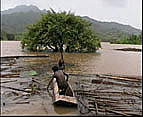

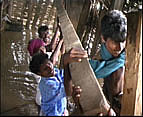
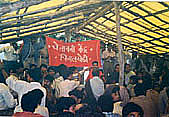
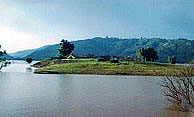
Tropical
Act Site: See Map India
Harm Site: India: Rural regions surrounding Gujaret, Maharashrta and Madhya Pradesh

Civil/Political
Intrastate, Low
Undetermined, as numbers and figures for fatalities are not adequately kept. There is no cumulative existence of the number of those killed through violent confrontation with police or those drowned in the floods. Most accurately, the level is estimated at about 3 or 4; Medium.

Direct and Indirect
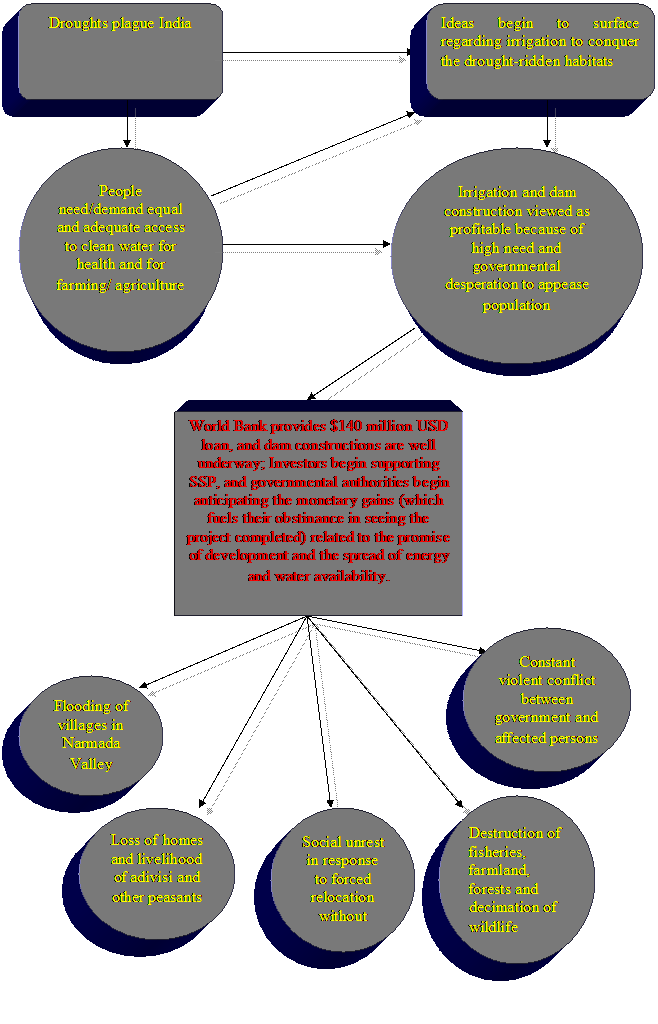
Stalemate/ In Progress:
Following over a decade and a half of sit-ins and protests, including numerous violent outbreaks, the people who stood to directly be affected by the construction of the Sardar Saravar Project, represented by the the NBA, took their battle to court in an attempt to prevent the construction of the dam. Primary to their concerns, besides from the fact that they were being forced out of their homes and villages, and essentially were having their livelihoods and lifestyles stripped from them, the people were even more infuriated by the fact that the government demonstrated a clear inability to facilate or even plan an adequate relocation project for the thousands flooded out of their homes. On October 18, 2000, after hearing the case, the Supreme Court of India finally declared its judgment regarding the Sardar Sarovar Project in a ninety-five page order. The Court permitted the construction of the dam to a preliminary height of ninety meters. Further, the Supreme Court granted the SSP contractors the right to proceed to elevate the height of the dam to the originally planned height of 138 meters, in five meter increments, only once the government demonstrated that there was a relocation policy in effect. Therefore, prior to the elevation in height, approval had to be granted from the Relief and Rehabilitation Subgroup of the Narmada Control Authority. ( For a thorough legal analysis and review of the Supreme Court judgment and to read the actual order, click here. )
To this day, the people of the region are clearly not happy with the results and continue to protest the heightening of the dam. Such incidents as the December 2002 protest where over 60 men and women were beaten up and arrested, and their crops of chilly, onion and cotton were destroyed persist.
"On July 27, 2003, the Maharashstra Governmentment sent a police force to Chimalkedi, one of the villages marroned int an island due to submergence. The Police force destroyed homes, let cattle loose and forcibly evicted the villagers and moved them to tin sheds, arresting 74 people, including women, children and activists."32
The Sardar Sarovar Dam continues to rise in height. However, adequate plans for rahabilitation and re-settlement are still reportedly not provided. The NBA, adivisi, and activists continue with their struggle.

NILE Nile and Conflict, Michele Ameri (June, 1997)
JORDAN Jordan River Dispute, by Lilach Grunfeld, (Spring 1997)
KALIMAN Ethnic Conflict and Deforestation in Kalimantan (Indonesia), by Dianne Linder (November, 1997)
LITANI Litani River and Israel-Lebanon, by Angela Joy Moss (November, 1997)
CHILEDAM The Bio-Bio River Case, Chile, by Carl Meachum (January, 1998)
MEKONG Mekong Dam in Laos and Environmental Impacts (Cross link to TED case 258), by Paul F. Macek (January 1996)
AMUR Amur River and Russia and China Territorial Dispute (TED Cross List), by Kung Mao Ya (January 2004)
TIGRIS Tigris-Euphrates River Dispute, by Tevfik Emin Kor (November, 1997)
BLUENILE Nile River Dispute, by Heather Hamilton (November, 1997)
14. Relevant Websites and Literature
Narmada Water Disputes Tribunal Award (NWDT)
The Supreme Court ruling, critiques, news clips etc.
Till the Rivers All Run Dry: A Human Ecological Analysis of the Narmada Bachao Andolan Prasenjit Maiti
Who pays? Who profits?; A short guide to the Sardar Sarovar Project
SSP no use for Saurashtra, admits CM; Indian Express, February 27, 2000
The Holister River : Chapter One of "Masters of Illusion : The World Bank and the Poverty of Nations" by Catherine Caufield.
Sardar Sarovar: A brief booklet published by INTACH
"Sardar Sarovar Project (SSP): An Overview", Patrick McCully, IRN's Campaigns Director, May 25, 1994 .
"Exercising the Other Option", The Economic Times, New Delhi, 8 October 1994, detailing alternative power and water schemes to Sardar Sarovar.
"A Brief Report on SSP Benchmarks", Patrick McCully, April 1, 1993 . IRN's Campaigns Director examines the failure of Sardar Sarovar to meet performance benchmarks set forth by the Indian Government and the World Bank.
"Confidential World Bank Evaluation Admits Future of Narmada Dam Uncertain", IRN, May 16, 1995 .
"Irrigation Project Threatens Endangered Mammal", January 7, 1995 . A report on the threat the SSP poses to the endangered Wild Ass.
Operations Evaluation Department Memo to World Bank, March 29, 1995 . A confidential memo critical of the SSP.
"Narmada Human Rights Observers' Visit, July 2-8, 1993". A report on the findings of a human rights team's visit to the dam, resettlement and other affected sites.
"A Report of the Narmada International Human Rights Panel", October 1993. A report extensively detailing the excessive use of force by the police against activists and others.
SSP impasse: Is there a solution; May 1997; Economic Times
"Sardar Sarovar: Will the Courts Advise Study of Alternatives?". A report on a meeting in Delhi that examined alternatives to Sardar Sarovar.
1 Dams and Development, A New Framework for Decision Making, A report by the World Commision on Dams, pg. 14.
2 Id. at pgs. 1, 11, 13.
3See generally, Id. at 168-86
4 McCully, P., Excercising the Other Option, available at http:www.irn.org/irn/ programs/narmada/irnoverview940525.html. (1994).
5 Wood, J., India's Narmada River Dams: Sardar Sarovar Under Siege, Asian Survey 33: 968-964 (1993).
6 McCully, P. 1994, Excercising the OTher Option, available at http:www.irn.org/irn/ programs/narmada/irnoverview940525.html.
7 Dixon, J. A., L.M Talbot, and G. Le Moigne. Dams and The Environment. Washington: The World Bank (1989).
8 Alvares, C., and R. Billorey, Damning the Narmada: The Politics Behind the Destruction,The Ecologist 12(2):62-73 (1987).
9 Id. at 63.
10 Environmental Economics Node- Environmental Problems and Judicial Intervention, avaialable at http://envis.mse.ac.in/legis-int.htm.
11 Id.
12Friends of the Narmada, The Sadar Sarovar Dam: a Brief Introduction, available at http://www.narmada.org/sardarsarovar.html#intro.
13 Aid Watch, Urgent Action: Rising Waters of Sardar Sarovar Dam in India, By Forest People's Programme, August 13, 2003.
14 Id.
15Environmental Economics Node- Environmental Problems and Judicial Intervention, avaialable at http://envis.mse.ac.in/legis-int.htm.
16 The Indian Economy Overview, The World Bank and India, available at http://www.ieo.org/world-c1-p3.html
17Environmental Economics Node- Environmental Problems and Judicial Intervention, avaialable at http://envis.mse.ac.in/legis-int.htm.
18Id.
19Aid Watch, Urgent Action: Rising Waters of Sardar Sarovar Dam in India, By Forest People's Programme, August 13, 2003.
20Environmental Economics Node- Environmental Problems and Judicial Intervention, avaialable at http://envis.mse.ac.in/legis-int.htm.
21Id.
22Id.
23Id.
24Id.
25Alvares, C., and R. Billorey, Damning the Narmada: The Politics Behind the Destruction,The Ecologist 12(2): 69 (1987).
26Jayaraman, K.S., Narmada Valley Irrigation Plan A Test Case for World Bank, Nature 335: 583.
27Alvares, C., and R. Billorey, Damning the Narmada: The Politics Behind the Destruction, The Ecologist 12(2): 69 (1987).
28Id.
29Id. at 66-67.
30Id. at 70.
31 Id.
32 Aid Watch, Urgent Action: Rising Waters of Sardar Sarovar Dam in India, By Forest People's Programme, August 13, 2003.
